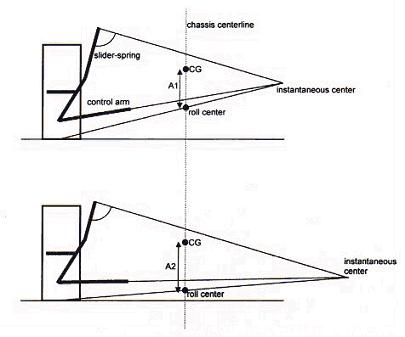The key point is that as a MacPherson strut suspension is lowered, the length of
this lever arm increases. Just compare A1 to A2 in the figure
above.
Thus even though the car is lower,
it will have a greater tendency towards roll.
This is not what many people expect when they lower a car.
There are obvious benefits to lowering a
car in terms of reduced weight transfer.
Also, the lower roll center (which results from lowering a strut suspension)
implies low instant centers for the two front wheels.
And this means less lateral scrub of the front tires as they move up and down through
their travel range (lateral scrub is not good as it can cause the car to wander left and right
as the suspension encounters one-wheel bumps).
Having instant centers (and thus a roll center) close to ground level
will also reduce "jacking" forces. Jacking forces occur when the lateral force at the tire
contact patch causes a torque (moment) around the roll center in such a way that the car
raised up when cornering. This is generally considered a bad handling trait.
But there is rarely a free lunch in anything, and this is no exception.
There are possible disadvantages to lowering a strut based front suspension:
increased roll couple, a possible negative effect on camber curves
and also possible increase in bump-steer.
Note that by lowering the car one has not changed the geometry
of the front suspension. Thus bump steer and camber curves are not really
changed per se. It's just that we have moved our static condition to a
different point on the original factory bump steer and camber gain curves.
We may not longer be on the "optimum" point on the curves therefore.
This is an often misunderstood distinction.
In conclusion, lowering your car involves
a trade off. Lower is often better, but too low is not necessarilly good either.
If you stiffen the front springs at the same time that you lower your car
(this is usually the case) then the stiffer springs offer an increased
roll rate to counter-act the increased roll couple. In this case
you get reduced weight transfer without necesarilly increasing roll.
And often the reduction in weight transfer will offset the possible reduced camber
curve and bump steer effects enough that the car will ulitmately be faster
around a track. However, you should not lower your car without at
least being aware of the possible negative consequences.
